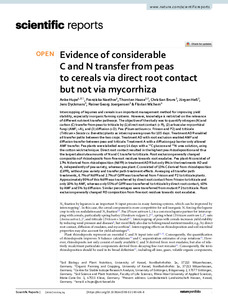| dc.date.accessioned | 2022-01-05T10:08:58Z | |
| dc.date.available | 2022-01-05T10:08:58Z | |
| dc.date.issued | 2021-06-01 | |
| dc.identifier | doi:10.17170/kobra-202112215306 | |
| dc.identifier.uri | http://hdl.handle.net/123456789/13483 | |
| dc.description.sponsorship | Gefördert durch den Publikationsfonds der Universität Kassel | ger |
| dc.language.iso | eng | eng |
| dc.rights | Namensnennung 4.0 International | * |
| dc.rights.uri | http://creativecommons.org/licenses/by/4.0/ | * |
| dc.subject | plant sciences | eng |
| dc.subject | stable isotope analysis | eng |
| dc.subject.ddc | 570 | |
| dc.subject.ddc | 580 | |
| dc.title | Evidence of considerable C and N transfer from peas to cereals via direct root contact but not via mycorrhiza | eng |
| dc.type | Aufsatz | |
| dcterms.abstract | Intercropping of legumes and cereals is an important management method for improving yield stability, especially in organic farming systems. However, knowledge is restricted on the relevance of different nutrient transfer pathways. The objective of the study was to quantify nitrogen (N) and carbon (C) transfer from peas to triticale by (1) direct root contact (= R), (2) arbuscular mycorrhizal fungi (AMF; = A), and (3) diffusion (= D). Pea (Pisum sativum cv. Frisson and P2) and triticale (Triticum × Secale cv. Benetto) plants as intercrop were grown for 105 days. Treatment ADR enabled all transfer paths between the two crops. Treatment AD with root exclusion enabled AMF and diffusion transfer between peas and triticale. Treatment A with a diffusion gap barrier only allowed AMF transfer. Pea plants were labelled every 14 days with a 13C glucose and 15N urea solution, using the cotton wick technique. Direct root contact resulted in the highest pea rhizodeposition and thus the largest absolute amounts of N and C transfer to triticale. Root exclusion generally changed composition of rhizodeposits from fine root residues towards root exudates. Pea plant-N consisted of 17% N derived from rhizodeposition (NdfR) in treatment ADR but only 8% in the treatments AD and A, independently of pea variety, whereas pea plant-C consisted of 13% C derived from rhizodeposition (CdfR), without pea variety and transfer path treatment effects. Averaging all transfer path treatments, 6.7% of NdfR and 2.7% of CdfR was transferred from Frisson and P2 to triticale plants. Approximately 90% of this NdfR was transferred by direct root contact from Frisson to triticale and only 10% by AMF, whereas only 55% of CdfR was transferred to triticale by direct root contact, 40% by AMF and 5% by diffusion. Similar percentages were transferred from mutant P2 to triticale. Root exclusion generally changed RD composition from fine root residues towards root exudates. | eng |
| dcterms.accessRights | open access | |
| dcterms.creator | Hupe, Anke | |
| dcterms.creator | Näther, Franziska | |
| dcterms.creator | Haase, Thorsten | |
| dcterms.creator | Bruns, Christian | |
| dcterms.creator | Heß, Jürgen | |
| dcterms.creator | Dyckmans, Jens | |
| dcterms.creator | Jörgensen, Rainer Georg | |
| dcterms.creator | Wichern, Florian | |
| dc.relation.doi | doi:10.1038/s41598-021-90436-8 | |
| dc.subject.swd | Hülsenfrucht | ger |
| dc.subject.swd | Getreide | ger |
| dc.subject.swd | Stickstoff | ger |
| dc.subject.swd | Kohlenstoff | ger |
| dc.subject.swd | Erbse | ger |
| dc.subject.swd | Übertragung | ger |
| dc.subject.swd | Triticale | ger |
| dc.type.version | publishedVersion | |
| dcterms.source.identifier | eissn:2045-2322 | |
| dcterms.source.journal | Scientific reports | eng |
| dcterms.source.volume | Volume 11 | |
| kup.iskup | false | |
| dcterms.source.articlenumber | 11424 | |


